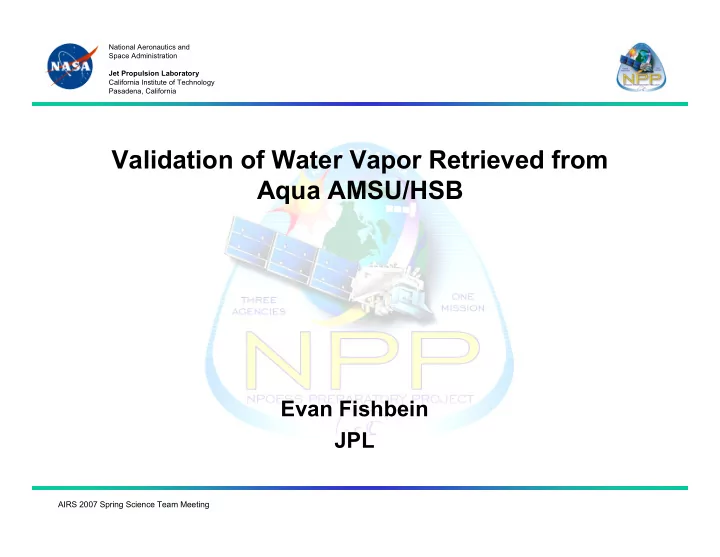

National Aeronautics and Space Administration Jet Propulsion Laboratory California Institute of Technology Pasadena, California Validation of Water Vapor Retrieved from Aqua AMSU/HSB Evan Fishbein JPL AIRS 2007 Spring Science Team Meeting
Motivation • What are the limitations of using CrIS/ATMS for climate research? • Measurement requirements are lower for cloudy scenes • Possibility of state-correlated errors, i.e. “sampling errors” • High flux regimes, e.g. frontal systems and convectively unstable • Water vapor is expected to show largest sampling errors • Variability correlates with cloudiness and saturation • AIRS/AMSU/HSB provide a proxy for CrIS/ATMS • Independent coincident microwave measurements facilitate assessment • Dedicated radiosondes have limited sampling • AMSU/HSB water vapor product must be validated AIRS 2007 Spring Science Team Meeting –2–
Why Characterize the Aqua Microwave WV Product? • AMSU/HSB less capable than AIRS • Fewer channels • Poorer pre-launch/post-launch calibration • Higher noise (HSB) • Poorer spatial resolution (AMSU-A) • But, microwave and infrared radiometry have different sampling (null-space) error characteristics Issue Microwave Infrared Surface Emissivity dependent on soil and vegetation moisture, Emissivity weakly dependent on moisture and composition and texture texture. Linear dependence of Planck ( T/E separation difficult) Nonlinear Planck facilitates T/E separation Large view angle, polarization and wind-dependence Emission is mostly Lambertian Large radiometric contrast over ocean Ocean emissivity weakly dependent on wind and emissivity and close to unity Clouds Weakly sensitive, except for precipitating clouds Strong sensitivity to clouds Field of Large radiometric contribution from antenna side-lobes FOV has sharp boundaries View FOV filling of calibration targets Calibration targets fill FOV AIRS 2007 Spring Science Team Meeting –3–
Instrument Characteristics HSB AIRS Vertical Range Surface to 0.2 kg/m 2 Surface to 0.04 kg/m 2 400 hPa 150 hPa Vertical Resolution 3 – 4 km 1 – 2 km ~3 degrees of freedom ~8 degree of freedom AIRS 2007 Spring Science Team Meeting –4–
Global AIRS vs AMSU/HSB Properties, Total Precipitable Water AIRS 2007 Spring Science Team Meeting –5–
Global ECMWF / HSB Properties, Profiles AIRS 2007 Spring Science Team Meeting –6–
ECMWF / HSB Zonal Cross Sections 11 Nov 2002 1200 UT Analysis 11 Nov 2002 L3 Maps 3 days of data Ascending & Descending AIRS 2007 Spring Science Team Meeting –7–
ECMWF / HSB Global Maps L3 Maps (2 days of data, ascending & descending) 11 Nov 2002 700 hPa AIRS 2007 Spring Science Team Meeting –8–
ECMWF / HSB Time Series • Time Series from 1200 UT Analyses / L3 Maps • 500 hPa AIRS 2007 Spring Science Team Meeting –9–
Radiosondes – Chesapeake • Statistics from all Sondes AIRS 2007 Spring Science Team Meeting –10–
Individual Radiosondes – Chesapeake AIRS 2007 Spring Science Team Meeting –11–
Individual Radiosondes – Chesapeake AIRS 2007 Spring Science Team Meeting –12–
ECMWF Radiosonde AMSU/HSB Comparison • ECMWF – AMSU/HSB biases are smaller in region of sensitivity • Correlated errors • ECMWF – AMSU/HSB standard deviation also smaller • Indicative of overly-stiff a priori covariance matrix AIRS 2007 Spring Science Team Meeting –13–
Conclusions • Comparison with ECMWF • Both capture equator to pole transport of moisture in frontal systems • Both show corresponding features and coincident timing in zonal means • Radiosonde Comparisons • Adjacent AMSU/HSB profiles are more alike than radiosonde profile • Summary • Accuracy ~ 20% • Precision ~ 40% • Possible over-dampening in OE retrieval • Additional Works • Additional analyses with other dedicated RS-80/90 radisonde launch sites AIRS 2007 Spring Science Team Meeting –14–
Recommend
More recommend